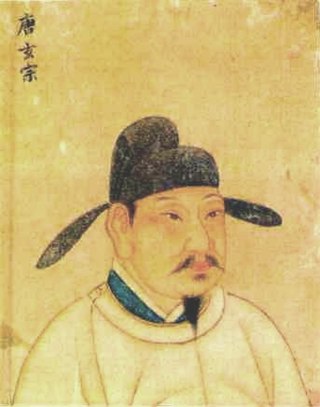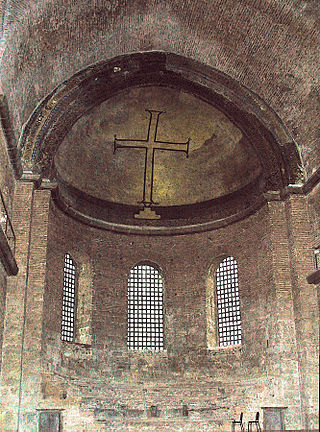| Tiberius Petasius | |||||||||
|---|---|---|---|---|---|---|---|---|---|
| Usurper of the Byzantine Empire | |||||||||
 Solidus minted in Tiberius' name | |||||||||
| Reign | c.730/731 | ||||||||
| Predecessor | Leo III | ||||||||
| Successor | Leo III | ||||||||
| Died | 730/731 | ||||||||
| |||||||||
Tiberius Petasius was a Byzantine usurper in Italy c.730/731.
| Tiberius Petasius | |||||||||
|---|---|---|---|---|---|---|---|---|---|
| Usurper of the Byzantine Empire | |||||||||
 Solidus minted in Tiberius' name | |||||||||
| Reign | c.730/731 | ||||||||
| Predecessor | Leo III | ||||||||
| Successor | Leo III | ||||||||
| Died | 730/731 | ||||||||
| |||||||||
Tiberius Petasius was a Byzantine usurper in Italy c.730/731.
Very little of Tiberius' life is known, other than that he was born Petasius, [1] and that he revolted against the Byzantine Emperor Leo III the Isaurian (r. 717–741) [2] in either 730 or 731, [3] [4] in Tuscia, Italy, [5] [6] taking the regnal name Tiberius. [1] It is possible that he was acclaimed as emperor by local Italian assemblies, who subsequently lost heart when the rebellion of Agallianos Kontoskeles in Greece was crushed. [7] Tiberius gained the allegiance of several towns near Tuscia, including Castrum Manturianense (identified by the historian Ludovico Muratori as modern-day Barbarano Romano), Blera, and Luna (modern-day location unknown, but likely not the Luna in northern Etruria); Tiberius based himself out of Castrum Manturianense. [4]
The Exarch of Ravenna, Eutychius (r. c.727 – 751), was sent to suppress Tiberius' revolt. Eutychius was short on manpower, thus Pope Gregory II (r. 715–731), who did not support Leo III, but opposed the creation of rival emperors, sent several bishops, as well as Papal forces to support Eutychius. [2] [5] [6] Their combined armies marched to Castrum Manturianense, crushed the rebellion in battle, and killed Tiberius. [4] [5] [6] After killing Tiberius, Eutychius sent his head to Leo III. [2]
The issue of Iconoclasm may have played a part in Tiberius' revolt, with Tiberius deriving support from Italians who opposed Leo III's iconoclastic policies, [8] although the only source which states that the anti-Iconoclastic sentiment of the Italians was related to the revolt of Tiberius comes from a much later anti-Iconoclast. [9]

Leo III the Isaurian, also known as the Syrian, was the first Byzantine emperor of the Isaurian dynasty from 717 until his death in 741. He put an end to the Twenty Years' Anarchy, a period of great instability in the Byzantine Empire between 695 and 717, marked by the rapid succession of several emperors to the throne, along with ending the continual defeats and territorial losses the Byzantines had suffered during the 7th century. He also successfully defended the Empire against the invading Umayyads and forbade the veneration of icons.

Year 730 (DCCXXX) was a common year starting on Sunday of the Julian calendar. The denomination 730 for this year has been used since the early medieval period, when the Anno Domini calendar era became the prevalent method in Europe for naming years.

Philippicus was Byzantine emperor from 711 to 713. He took power in a coup against the unpopular emperor Justinian II, and was deposed in a similarly violent manner nineteen months later. During his brief reign, Philippicus supported monothelitism in Byzantine theological disputes, and saw conflict with the First Bulgarian Empire and the Umayyad Caliphate.

Theodosius III was Byzantine emperor from c. May 715 to 25 March 717. Before rising to power and seizing the throne of the Byzantine Empire, he was a tax collector in Adramyttium. In 715, the Byzantine navy and the troops of the Opsician Theme, one of the Byzantine provinces, revolted against Emperor Anastasius II, acclaiming the reluctant Theodosius as emperor. Theodosius led his troops to Chrysopolis and then Constantinople, the capital, seizing the city in November 715. Anastasius did not surrender until several months later, accepting exile in a monastery in return for safety. Many themes viewed Theodosius to be a puppet of the troops of the Opsician Theme, and his legitimacy was denied by the Anatolics and the Armeniacs under their respective strategoi (generals) Leo the Isaurian and Artabasdos.

Nikephoros I, also known as Nicephorus I, was Byzantine emperor from 802 to 811. He was General Logothete under Empress Irene, but later overthrew her to seize the throne for himself. Prior to becoming emperor, he was sometimes referred to as "the Logothete" and "Genikos" or "Genicus", in recognition of his previous role as General Logothete.

Theophilos was Byzantine Emperor from 829 until his death in 842. He was the second emperor of the Amorian dynasty and the last emperor to support iconoclasm.

Irene of Athens, surname Sarantapechaena, was Byzantine empress consort to Emperor Leo IV from 775 to 780, regent during the childhood of their son Constantine VI from 780 until 790, co-ruler from 792 until 797, and finally empress regnant and sole ruler of the Eastern Roman Empire from 797 to 802. A member of the politically prominent Sarantapechos family, she was selected as Leo IV's bride for unknown reasons in 768. Even though her husband was an iconoclast, she harbored iconophile sympathies. During her rule as regent, she called the Second Council of Nicaea in 787, which condemned iconoclasm as heretical and brought an end to the first iconoclast period (730–787). During her 5 year sole reign, her public figure was polarizing, due to the setbacks faced by the Empire and her iconophilic stances, often attributed to her gender and the influence of her retinue. Her reign as sole ruler made her the first ever empress regnant, ruling in her own right, in Roman and Byzantine imperial history.

Michael I Rangabe was Byzantine emperor from 811 to 813. A courtier of Emperor Nikephoros I, he survived the disastrous campaign against the Bulgars and was preferred as imperial successor over Staurakios, who was severely injured. He was proclaimed emperor by Patriarch Nicephorus I of Constantinople on 2 October 811.

Michael II, called the Amorian and the Stammerer, reigned as Byzantine emperor from 25 December 820 to his death on 2 October 829, the first ruler of the Amorian dynasty.

Artabasdos or Artavasdos, Latinized as Artabasdus, was a Byzantine general of Armenian descent who seized the throne from June 741 until November 743, in usurpation of the reign of Constantine V.

Leontius was Byzantine emperor from 695 to 698. Little is known of his early life, other than that he was born in Isauria in Asia Minor. He was given the title of patrikios, and made strategos of the Anatolic Theme under Emperor Constantine IV. He led forces against the Umayyads during the early years of Justinian II's reign, securing victory and forcing the Umayyad caliph, Abd al-Malik ibn Marwan, to sue for peace.

Tiberius III, born Apsimar, was Byzantine emperor from 698 to 705. Little is known about his early life, other than that he was a droungarios, a mid-level commander, who served in the Cibyrrhaeot Theme. In 696, Tiberius was part of an army sent by Byzantine Emperor Leontius to retake the North African city of Carthage, which had been captured by the Arab Umayyads. After seizing the city, this army was pushed back by Umayyad reinforcements and retreated to the island of Crete. As they feared the wrath of Leontius, some officers killed their commander, John the Patrician, and declared Tiberius the emperor. Tiberius swiftly gathered a fleet and sailed for Constantinople, where he then deposed Leontius. Tiberius did not attempt to retake Byzantine Africa from the Umayyads, but campaigned against them along the eastern border with some success. In 705, former emperor Justinian II, who had been deposed by Leontius, led an army of Slavs and Bulgars from the First Bulgarian Empire to Constantinople, and after entering the city secretly, deposed Tiberius. Tiberius fled to Bithynia, but was captured a few months later and beheaded by Justinian between August 705 and February 706. His body was initially thrown into the sea, but was later recovered and buried in a church on the island of Prote.

Constantine V was Byzantine emperor from 741 to 775. His reign saw a consolidation of Byzantine security from external threats. As an able military leader, Constantine took advantage of civil war in the Muslim world to make limited offensives on the Arab frontier. With this eastern frontier secure, he undertook repeated campaigns against the Bulgars in the Balkans. His military activity, and policy of settling Christian populations from the Arab frontier in Thrace, made Byzantium's hold on its Balkan territories more secure. He was also responsible for important military and administrative innovations and reforms.
Eutychius was the last Exarch of Ravenna, heading the Exarchate from 726 or 727 until 751.

Antony I of Constantinople Ecumenical Patriarch of Constantinople from January 821 to 21 January 837.

The Byzantine Iconoclasm were two periods in the history of the Byzantine Empire when the use of religious images or icons was opposed by religious and imperial authorities within the Ecumenical Patriarchate and the temporal imperial hierarchy. The First Iconoclasm, as it is sometimes called, occurred between about 726 and 787, while the Second Iconoclasm occurred between 814 and 842. According to the traditional view, Byzantine Iconoclasm was started by a ban on religious images promulgated by the Byzantine Emperor Leo III the Isaurian, and continued under his successors. It was accompanied by widespread destruction of religious images and persecution of supporters of the veneration of images. The Papacy remained firmly in support of the use of religious images throughout the period, and the whole episode widened the growing divergence between the Byzantine and Carolingian traditions in what was still a unified European Church, as well as facilitating the reduction or removal of Byzantine political control over parts of the Italian Peninsula.

The Opsician Theme or simply Opsikion was a Byzantine theme located in northwestern Asia Minor. Created from the imperial retinue army, the Opsikion was the largest and most prestigious of the early themes, being located closest to Constantinople. Involved in several revolts in the 8th century, it was split in three after ca. 750, and lost its former pre-eminence. It survived as a middle-tier theme until after the Fourth Crusade.
Arsaber, was a Byzantine noble who attempted an unsuccessful usurpation of the Byzantine imperial throne in 808.

Heraclius was Byzantine co-emperor from 659 to 681. He was the son of Emperor Constans II and Fausta, who was elevated in 659, before his father departed for Italy. After the death of Constans, Heraclius' brother Constantine IV ascended the throne as senior emperor. Constantine attempted to have both Heraclius and Tiberius removed as co-emperors. However, this sparked a popular revolt in 681. Constantine ended the revolt by promising to accede to the demands of the rebels, sending them home, but bringing their leaders into Constantinople. Once there, Constantine had them executed, then imprisoned Tiberius and Heraclius and had their noses slit, after which point they disappear from history.

Nikephoros was junior Byzantine Emperor from 741 to 743. He was crowned after his father, Artabasdos usurped Emperor Constantine V. Constantine seized power again on 2 November 743, and Nikephoros, Artabasdos, and Niketas were blinded and confined in the Chora Church.